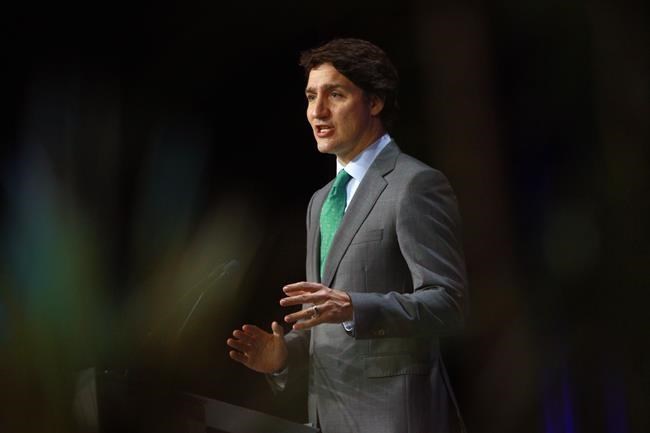CALGARY — Canada's oil and gas industry remains in the dark about exactly how much it will be required to reduce its emissions in the coming decade, though a sweeping new plan unveiled by Ottawa on Tuesday suggests the goalposts will be ambitious.
The federal government's new emissions-reduction plan, which was tabled in the House of Commons, lays out ways the country can reach its target of cutting emissions by 2030 to nomore than 60 per cent of 2005 levels.
In it, the government says Canada's oilpatch is capable of reducing emissions by 31 per cent below 2005 levels by 2030, or 42 per cent below 2019 levels. (Emissions from the sector have risen by 20 per cent since 2005, due to increased production, though emissions intensity per barrel has decreased).
That would bring total emissions from the sector — including production, refining and transportation via pipelines — to 110 million tonnes by 2030, down from 191 million tonnes in 2019. They haven't been that low in more than three decades.
But those numbers are simply projections, they are not the mandated cap on oil and gas emissions the Liberals promised as part of their fall election platform, said Environment Minister Steven Guilbeault.
The government is currently consulting with industry as well as the provinces, Indigenous groups and other interested parties about what that cap will be, whether it will be legislated or regulatory, and what the compliance tools will be.
"The numbers you see for different sectors are projections of where, based on our analysis . . . different sectors should be in 2030 for us to get to our targets," Guilbeault said. "But it's not in any way, for any sectors, a regulated cap or target."
Guilbeault said the targets laid out are "ambitious" and that word was echoed by oil and gas industry groups responding to the government's plan.
“There are economic limits, and time limits, on what we can achieve by 2030," said Mark Cameron, senior adviser for the OIlsands Pathways to Net Zero Alliance, a group of six major oilsands companies that have together committed to reaching net-zero greenhouse gas emissions by 2050.
Cameron said the oilsands subsector, through the Pathways group, has set its own interim goal of reducing oilsands production emissions by 22 million tonnes by 2030. That would represent an approximate 30 per cent reduction from current levels, and is a "realistic and achievable" goal, Cameron said.
The oilsands industry's vision is anchored by a proposed major carbon capture and storage transportation line that would capture CO2 from oilsands facilities and transport it to a storage facility near Cold Lake, Alta.
The project could be up and running by the end of the decade, delivering about 10 million tonnes of emissions reductions, but Cameron said it's dependent on an investment tax credit for carbon capture projects that is expected to be part of next week's federal budget.
“We’re competing for international capital for these projects. And jurisdictions like the U.S., like Netherlands, like Norway, have very, very generous financial terms for carbon capture and storage," he said.
Tristan Goodman, president of industry group The Explorers and Producers Association of Canada, said there is scope for oil and gas producers to reduce emissions even further by doing things like switching to renewable sources of electricity to power operations.
But he warned that if the government sets an overly ambitious target, it will scare investment dollars away.
“At some point, what you don’t want to happen is you don’t want to start damaging the economy or having production simply shift to another jurisdiction. That doesn’t help anyone, and it certainly doesn’t help in reducing emissions," he said.
However, environmental groups say there is room for Canada to set a more ambitious cap for the oil and gas sector. They say the oil and gas sector can achieve the 31 per cent reduction below 2005 levels by using existing technology.
"Those (federal targets) are significant reductions, but they’re not good enough. There’s actually room to be more ambitious," said Simon Dyer, deputy executive director of environmental think-tank the Pembina Institute. "And if we actually want to drive industry to make the investments in carbon capture and storage and methane abatement, there could be a stronger cap."
Dyer said oil and gas companies are enjoying record-setting profits right now due to high commodity prices and are well-poised to make investments in decarbonization.
"The industry is not making those investments — it’s going to share buybacks instead," he said. "We should be seeing billions of dollars of investment from the oil and gas industry in carbon reduction measures, and we’re simply not seeing it.”
Guilbeault said he understands that some Canadians would like to see the government be even more ambitious, but said it's important to also be "pragmatic and realistic."
"I mean, talk is cheap," he said. "We could have very ambitious targets and not know how we get there. I don't think that would serve Canadians well."
— With files from Mia Rabson in Ottawa
This report by The Canadian Press was first published March 29, 2022.
Amanda Stephenson, The Canadian Press



